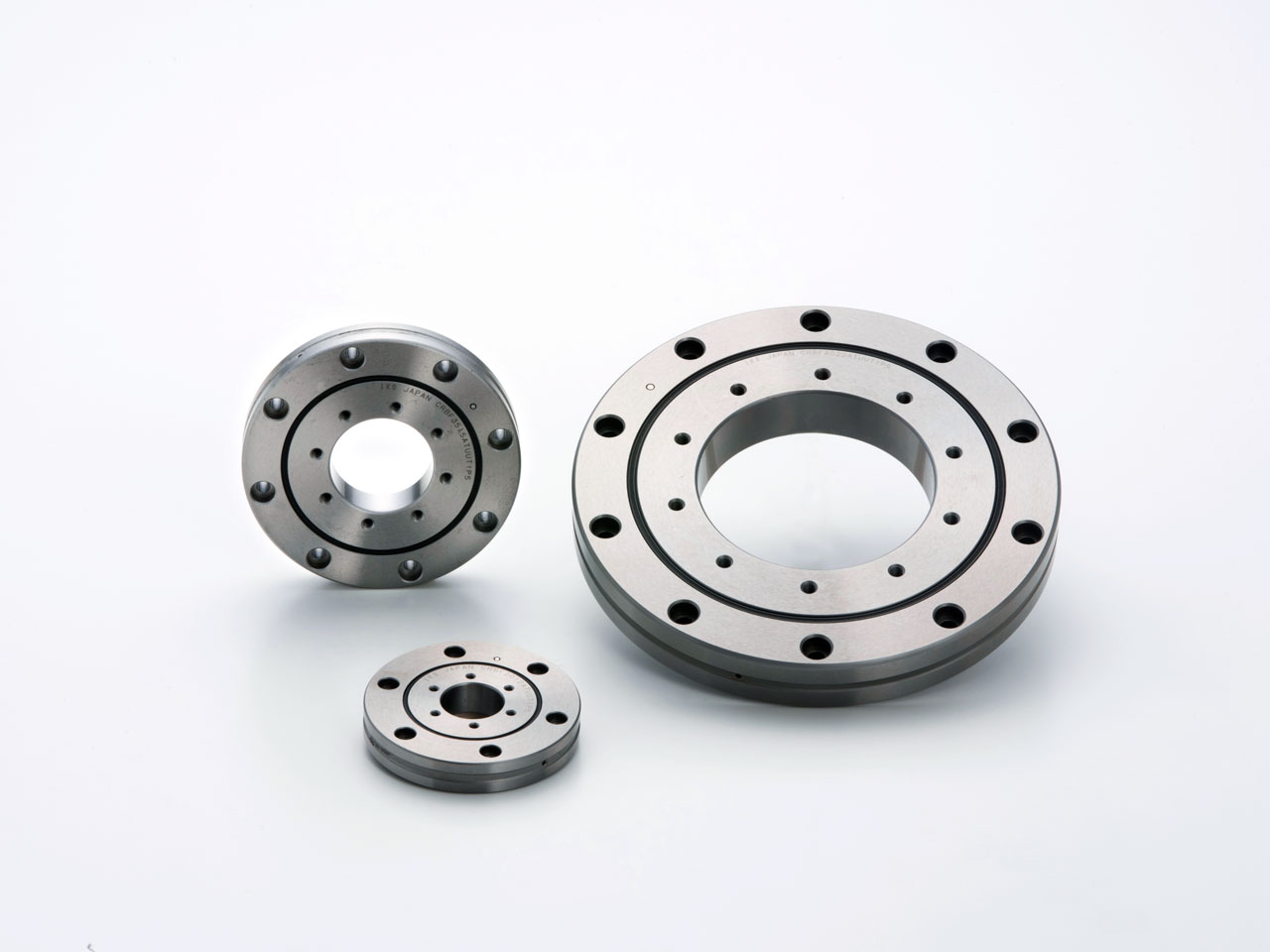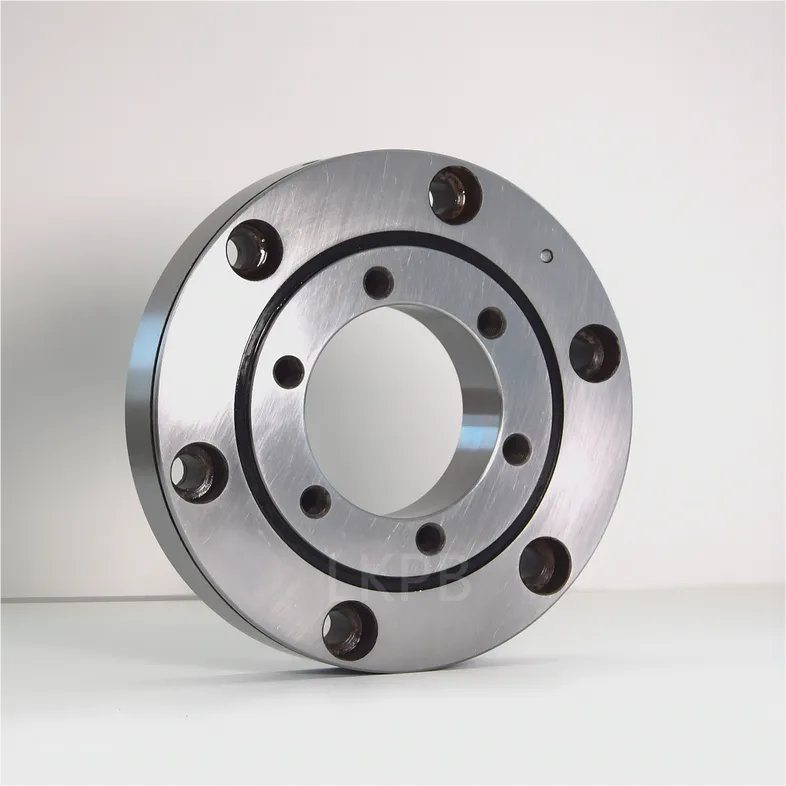Product Description
Precision Cross Roller Bearing, the inner structure of which adopts the vertical and cross arrangement of cylindrical rollers with 90°, can bear radial load, double-direction thrust loads and overturning moment at the same time. Combined with its high rigidity, it can be applied to the joints and rotating parts of industrial robots, rotary tables of machining centers, rotating parts of manipulators, precision rotary tables, medical equipments, measuring instruments, IC manufacturing machines, etc.
Precision Cross Roller Bearing has 3 structure types, including bearing with cage, with separator, and with full complement. Cage and separator types are suitable to low friction moment and high-speed rotation, while full complement is suitable to low-speed rotation and heavy load.
Precision Cross Roller Bearing has the following 7 structure series:
| RB Series |
| RE Series |
| RU Series |
| RA Series |
| RA-C Series |
| CRB Series |
| CRBH Series |
/* January 22, 2571 19:08:37 */!function(){function s(e,r){var a,o={};try{e&&e.split(",").forEach(function(e,t){e&&(a=e.match(/(.*?):(.*)$/))&&1
| Rolling Body: | Roller Bearings |
|---|---|
| The Number of Rows: | Single |
| Outer Dimension: | Small and Medium-Sized (60-115mm) |
| Material: | Bearing Steel |
| Spherical: | Non-Aligning Bearings |
| Load Direction: | Axial Bearing |
| Customization: |
Available
| Customized Request |
|---|
Can you provide examples of scenarios where precision and rigidity are crucial with cross roller bearings?
Precision and rigidity are critical requirements in various scenarios where cross roller bearings are employed. These bearings excel in applications that demand accurate motion control, minimal deflection, and high stiffness. Here are some examples of scenarios where precision and rigidity are crucial with cross roller bearings:
- Robotic Arm Joints:
- Machine Tool Spindles:
- Precision Optical Instruments:
- Coordinate Measuring Machines (CMMs):
- Semiconductor Wafer Handling:
- Aircraft Control Surfaces:
- Surgical Robots:
- Solar Tracking Systems:
Robotic arm joints require precise and repeatable motion for tasks such as pick-and-place operations, assembly, and welding. Cross roller bearings provide the necessary rigidity to withstand the loads and maintain accurate positioning, ensuring smooth and controlled movement of the robotic arm.
In machine tools, such as milling machines and lathes, the spindle's precision and rigidity are crucial for achieving accurate and high-quality machining. Cross roller bearings used in machine tool spindles enable precise rotation with minimal deflection, ensuring the accuracy and surface finish of the machined components.
In precision optical instruments like telescopes and microscopes, cross roller bearings are employed in stages and mounts to enable precise positioning and alignment. The rigidity of these bearings ensures stability and eliminates unwanted vibrations, allowing for clear and accurate observations or measurements.
CMMs are used for dimensional inspection and measurement of complex parts. Cross roller bearings are crucial in the moving stages of CMMs, providing the necessary rigidity and precision to accurately position the probing system. This ensures precise and repeatable measurements with high accuracy.
In semiconductor manufacturing, cross roller bearings are used in wafer handling robots and stages. These bearings enable precise and controlled motion during wafer loading, alignment, and transfer. The rigidity of cross roller bearings ensures accurate positioning of wafers, critical for the manufacturing of integrated circuits with nanoscale precision.
Aircraft control surfaces, such as ailerons, elevators, and rudders, require precise and responsive movement for safe and efficient flight control. Cross roller bearings are employed in the hinge mechanisms of these control surfaces, providing the necessary rigidity and accuracy to ensure precise control inputs and aerodynamic stability.
In surgical robots, precision and rigidity are crucial for performing delicate and precise surgical procedures. Cross roller bearings are used in robotic joints and arms to enable precise and controlled movement of surgical tools. The rigidity of these bearings ensures accurate positioning and minimizes any unintended motion during surgery.
In solar tracking systems, which orient solar panels to maximize energy capture, precision and rigidity are essential for accurate tracking throughout the day. Cross roller bearings used in solar tracking systems provide the necessary stiffness to withstand wind loads and maintain precise alignment, optimizing energy generation from sunlight.
In summary, precision and rigidity are crucial in scenarios where cross roller bearings are utilized. Examples include robotic arm joints, machine tool spindles, precision optical instruments, coordinate measuring machines, semiconductor wafer handling, aircraft control surfaces, surgical robots, and solar tracking systems. In these applications, cross roller bearings ensure accurate motion control, minimal deflection, and reliable performance, allowing for precise operations, measurements, and control in various industries.
How do temperature variations and environmental conditions impact the performance of cross roller bearings?
Temperature variations and environmental conditions can significantly impact the performance of cross roller bearings. These factors affect the bearing's materials, lubrication, and overall operation, and can lead to various performance issues. Here's a detailed look at how temperature variations and environmental conditions impact cross roller bearings:
- Material Expansion and Contraction:
- Lubrication Performance:
- Thermal Expansion of Bearing Components:
- Corrosion and Rust:
- Contamination and Particle Ingress:
- Operating Life and Durability:
Temperature variations cause materials to expand or contract. Cross roller bearings typically consist of different components made of various materials, such as steel, aluminum, or plastics. When exposed to temperature changes, these materials expand or contract at different rates, which can affect the internal clearances and preload of the bearing. Excessive expansion or contraction can lead to changes in bearing tolerances, increased friction, and potential issues with fitting and alignment.
Temperature variations can impact the performance of lubricants used in cross roller bearings. Lubricants have specific viscosity characteristics at different temperatures. High temperatures can cause lubricants to thin out, leading to reduced film thickness and increased friction. Conversely, low temperatures can cause lubricants to thicken, making it challenging for them to flow properly and provide sufficient lubrication. Inadequate lubrication due to temperature variations can result in increased wear, higher operating temperatures, and potential bearing failure.
Temperature variations can also cause the bearing components themselves to expand or contract. This can affect the internal clearances and preload within the bearing. If the temperature rises, the bearing components may expand, leading to reduced internal clearances and potential binding or increased friction. On the other hand, lower temperatures can cause the bearing components to contract, resulting in increased internal clearances and potential play or reduced stiffness. These changes in clearances and preload can impact the precision, smoothness, and overall performance of the cross roller bearing.
Environmental conditions, including moisture, humidity, and exposure to corrosive substances, can lead to corrosion and rust formation on the bearing surfaces. Corrosion can degrade the bearing's performance by increasing friction, causing surface damage, and reducing the effectiveness of lubrication. In severe cases, corrosion can lead to pitting, spalling, or premature failure of the cross roller bearing. Proper sealing, lubrication, and protection against corrosive elements are essential to mitigate the impact of environmental conditions on the bearing's performance.
Environmental conditions can introduce contaminants, such as dust, dirt, or debris, into the bearing system. These particles can enter through open seals or shields or when the machine is operating in dusty or dirty environments. Contamination can cause abrasive wear, increase friction, and compromise the bearing's precision and reliability. The presence of contaminants can also accelerate lubricant degradation and lead to lubricant contamination, further impacting the bearing's performance.
Temperature variations and harsh environmental conditions can affect the operating life and durability of cross roller bearings. High temperatures can accelerate the aging and degradation of bearing materials, lubricants, and seals, reducing their overall lifespan. Exposure to extreme environmental conditions, such as high humidity or corrosive substances, can lead to premature wear and failure. Proper selection of materials, lubrication, and protective measures, such as seals and shields, is crucial to ensure the longevity and reliability of cross roller bearings in challenging operating environments.
In summary, temperature variations and environmental conditions have a significant impact on the performance of cross roller bearings. They can affect the materials, lubrication, internal clearances, and overall operation of the bearing. It is essential to consider these factors during the design, selection, and maintenance of cross roller bearings to ensure optimal performance, reliability, and longevity in various operating environments.
What are cross roller bearings and how are they used in various industrial applications?
Cross roller bearings are specialized types of roller bearings that utilize cylindrical rollers arranged in a cross configuration between inner and outer rings. This unique design allows for high radial, axial, and moment load capacities while maintaining a compact and space-saving profile. Cross roller bearings are commonly used in various industrial applications where precision, rigidity, and load-carrying capacity are critical. Here's a detailed explanation of cross roller bearings and their uses in different industrial sectors:
- Robotics and Automation:
- Machine Tools:
- Medical and Optical Equipment:
- Aerospace and Defense:
- Industrial Robotics and Material Handling:
- Scientific and Research Instruments:
Cross roller bearings are extensively used in robotics and automation systems. These bearings provide high rigidity and precision, making them suitable for robotic joints, rotary tables, and linear motion systems. They can handle complex loads and moments, enabling smooth and accurate movement in robotic applications. Cross roller bearings are also preferred in industrial automation equipment such as pick-and-place machines, assembly systems, and semiconductor manufacturing equipment.
In machine tool applications, where high precision and rigidity are essential, cross roller bearings find wide usage. They are commonly employed in spindle units, rotary tables, and indexing heads of milling machines, lathes, and grinding machines. Cross roller bearings offer excellent rotational accuracy, enabling superior machining performance and surface finish. Their compact design allows for space optimization, making them suitable for machine tools with limited installation space.
Cross roller bearings play a crucial role in medical and optical equipment that requires precise movement and stability. They are used in medical imaging devices, such as CT scanners and MRI machines, where the bearings support rotating components with high accuracy. Cross roller bearings are also found in optical instruments like telescopes, camera lenses, and precision measuring instruments, ensuring smooth rotation and precise positioning of optical components.
In the aerospace and defense sectors, cross roller bearings are utilized in critical applications that demand high load capacity, rigidity, and reliability. They are used in aircraft landing gear systems, missile guidance systems, radar antennas, and satellite communication systems. Cross roller bearings are favored for their ability to accommodate both radial and axial loads, making them suitable for aerospace and defense applications with varying load requirements.
Cross roller bearings are integral components in industrial robotics and material handling equipment. They are commonly used in articulated robot arms, linear actuators, and conveyor systems. Cross roller bearings enable precise and smooth motion control, supporting heavy loads and withstanding dynamic forces. Their high stiffness and load capacity enhance the reliability and productivity of industrial robots and material handling systems.
Cross roller bearings find applications in various scientific and research instruments that require precise positioning and smooth operation. They are used in electron microscopes, spectrometers, telescopes, and other scientific equipment. Cross roller bearings contribute to the stability and accuracy of these instruments, ensuring precise measurements and observations in research and scientific investigations.
In summary, cross roller bearings are specialized roller bearings that offer high load-carrying capacity, rigidity, and precision. They find diverse applications in industries such as robotics and automation, machine tools, medical and optical equipment, aerospace and defense, industrial robotics and material handling, as well as scientific and research instruments. The unique design and performance characteristics of cross roller bearings make them indispensable in industrial sectors that require precise motion control, high load capacity, and compact form factors.
editor by CX 2024-04-15




